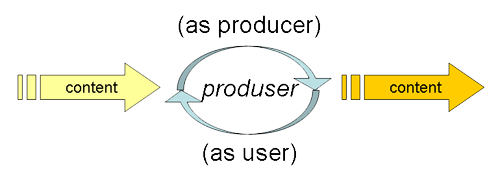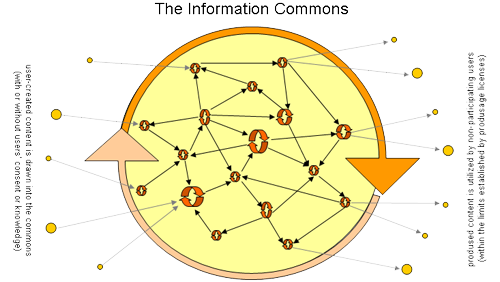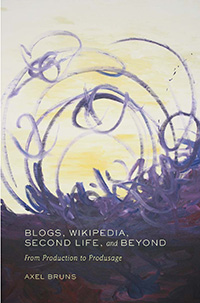You are here
Reading Sample 1 - Produsage: An Introduction
Below is the first of four reading samples from Blogs, Wikipedia, Second Life, and Beyond: From Production to Produsage. These samples were first published as part of a series on the P2P Foundation Website, where the book was honoured as Book of the Week.
In this series:
- Produsage: An Introduction
- Folks and Experts
- Produsage and Technology
- Produsage and Democracy
1 - Produsage: An Introduction
Users are able to involve themselves flexibly and fluidly in the tasks confronting the collaborative, 'hive' community; they collaborate not by performing only the monotonous, repetitive, predetermined tasks of the production line, or by contributing fully formed new ideas to the information commons, but instead engage in an ongoing, perpetually unfinished, iterative, and evolutionary process of gradual development of the informational resources shared by the community. Such "communality is powerful: It effectively eliminates the need to predict in advance who may benefit from one's knowledge; it provides information and expertise gained by others, thus eliminating the need to experience phenomena firsthand; and it highlights the advantages of aggregated information resources, whose value can greatly exceed the sum of the parts." [1]
Thus, the production value chain is transformed to the point of being entirely unrecognizable - in the absence of producers, distributors, or consumers, and the presence of a seemingly endless string of users acting incrementally as content producers by gradually extending and improving the information present in the information commons, the value chain begins and ends (but only temporarily, ready for further development) with content. Whether in this chain participants act more as users (utilizing existing resources) or more as producers (adding new information) varies over time and across tasks; overall, they take on a hybrid user/producer role which inextricably interweaves both forms of participation, and thereby become produsers.

Figure 1: The Produser
We must strive, then, to develop an even more systematic understanding of the processes of communal and collaborative development of content which take place here, and to develop the terminology required to describe them fully. In collaborative communities the creation of shared content takes place in a networked, participatory environment which breaks down the boundaries between producers and consumers and instead enables all participants to be users as well as producers of information and knowledge - frequently in a hybrid role of produser where usage is necessarily also productive. Produsers engage not in a traditional form of content production, but are instead involved in produsage - the collaborative and continuous building and extending of existing content in pursuit of further improvement. Participants in such activities are not producers in a conventional, industrial sense, as that term implies a distinction between producers and consumers which no longer exists; the artefacts of their work are not products existing as discrete, complete packages, as we will see; and their activities are not a form of production because they proceed based on a set of preconditions and principles that are markedly at odds with the conventional industrial model.
[…]

Figure 2: The Information Commons of Produsage
While produsage processes produce real outcomes, and while we could therefore describe produsage as a (commons-based, peer-to-peer) form of production, to understand the collaborative processes involved in produsage, and to examine their influence on the form and content of the information, knowledge, and creative work prodused in the process, our focus must turn elsewhere. An important consequence of this shift of focus, then, is also that we must revise our understanding of the outcomes of produsage process, distinguishing them from the products of the industrial model. Although produsage outcomes can substitute for conventional products, this dressing-up of the temporary outcomes of a continuing process as 'products' in their own right should not be misunderstood to indicate that these artefacts are anything but temporary, that they are anything other than artefacts. A physical product - and by extension, an informational product produced and distributed through conventional industrial models which are ultimately rooted in physical production paradigms - is defined by its boundedness; it is 'the complete package,' a self-contained, unified, finished entity. By contrast, the 'products' of the collaborative content creation efforts which we examine throughout this book are the polar opposites of such products: they are inherently incomplete, always evolving, modular, networked, and never finished. Their process of 'production' is a process of perpetual, ceaseless, continuous update, extension, and revision which operates not according to a predetermined blueprint or design, but is driven by the vagaries of user-producer interest in and enthusiasm for fixing specific problems or extending particular aspects of the project. Its outcomes are artefacts, not products.
The social, collaborative basis of the content creation communities engaged in produsage also indicates this; in produsage projects, the object of the communal effort is almost always as much the development of social structures to support and sustain the shared project as it is the development of that project itself. As von Hippel's term indicates, the object of such produsage is not simply information, but an information commons; in its full form, the information (knowledge, creative work) prodused by the community therefore exists not in abstraction from the social contexts of its development, as a stand-alone product, but exists only as directly embedded in such contexts, as a temporary artefact of continuing social processes of developing, extending, negotiating, and evaluating this shared content. [2] Just as we do not speak of 'producing' our social networks (we build, extend, maintain, improve them), in collaborative content creation much the same observation applies: here, too, content creation is an act of maintenance and construction (of both content and the social relationships among participants) at least as much as it is one of production. Most participants in content creation communities will therefore see themselves exactly as that: as participants, not as producers. Although their behavior in these communities may be 'productive' as their acts of participation accumulate, for some participants this may be only a corollary to their social use of the communal spaces, and to their engagement in the community.
-
Bruce Bimber, Andrew J. Flanagin, and Cynthia Stohl, "Reconceptualizing Collective Action in the Contemporary Media Environment," Communication Theory 15.4 (2005), p. 371.
-
Strictly speaking, this is true of some conventional products as well: the content of Encyclopædia Britannica is determined by the social context of its production - the make-up of its staff of editors and contributors - as much as the content of Wikipedia is determined by its community and the participatory protocols of that community. However, the distancing of production, distribution, and consumption as three distinct phases in the conventional value chain tends to obscure this significantly, enabling Britannica and other products to assume an aura of objectivity which neither applies to nor is pursued by most produsage communities and their artefacts.
- Log in to post comments
- 16654 reads
 Printer-friendly version
Printer-friendly version


